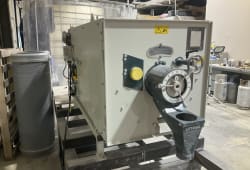Everything you want to know about Power Rakes
9 Min read
)
September 15, 2023
When it comes to maintaining a healthy, lush lawn, understanding the tools at your disposal is crucial. One such tool, often considered a game-changer in the world of lawn care, is the power rake. You might have also heard it referred to as a Harley rake or a power dethatcher, and it's a must-have for anyone serious about achieving a pristine lawn. Whether you're a seasoned landscaper, a tractor or bobcat owner, or just a curious homeowner, the world of power rakes holds valuable insights for you. We'll explore power rake attachments for tractors and bobcats, and even discuss the intriguing debate of power rake vs. dethatcher.
If you're wondering where to find a power rake rental near you or contemplating a purchase, we've got you covered on that front too. Let's dive deep into the world of power rakes, from rentals to sales, and become experts in this essential landscaping tool.
What is a Power Rake?
:format(webp))
When it comes to maintaining a healthy, lush lawn, understanding the tools at your disposal is crucial. One such tool, often considered a game-changer in the world of lawn care, is called the power rake. You might have also heard it referred to as a Harley rake or a power dethatcher, and it's a must-have for anyone serious about achieving a pristine lawn.
The Power Rake Unveiled
So, what exactly is a power rake? At its core, it's a specialized machine designed to remove thatch and debris from your lawn's surface. Thatch is a thick layer of dead grass, roots, and other organic matter that can accumulate on your lawn over time. While a little thatch is beneficial, too much of it can suffocate your grass, preventing essential nutrients, water, and air from reaching the soil. This leads to a lackluster, unhealthy lawn.
The power rake's primary mission is to combat thatch buildup. It features a series of rotating blades or tines that penetrate the thick thatch layer and pull or push it up to the surface. Once there, you can easily collect and dispose of the thatch, allowing your grass to breathe and thrive.
The Versatility of Power Rakes
But that's not all a power rake can do. It's a versatile tool with multiple functions. For example, it can also serve as a lawn scarifier and turf aerator, promoting healthy grass growth by creating small channels in the soil. These channels improve water penetration and root development.
Choosing the Right Power Rake
Now that you understand what a power rake does, you might be wondering how to choose the right one. There are various models available, including a Harley rake for skid steer and a Harley rake for tractor, each with its own set of features and capabilities.
If you're in the market, you'll want to explore options like a power rake for sale or a dethatcher for sale to find the best fit for your lawn care needs. Additionally, consider whether you want to buy a power rake or simply rent a dethatcher for occasional use.
How do you power-rake your Lawn?
Achieving a pristine, healthy lawn often involves using the right tools and techniques. Among these tools, the power rake stands out as a valuable asset in your lawn care arsenal. Whether you've recently invested in a power rake for sale or you're considering a power rake rental near me, understanding how to use this powerful machine effectively is crucial. In this guide, we'll delve into the ins and outs of power raking, and its advantages over traditional dethatching methods, and provide you with valuable tips for a job well done.
The Power Rake vs. Dethatcher Debate
Before we dive into the "how," let's briefly address the "why." Why choose a power rake over a traditional dethatcher? The answer lies in efficiency and effectiveness. While dethatchers can be useful for smaller lawns with minimal thatch buildup, a power rake takes lawn care to the next level. Its rotating blades or tines penetrate deep into the thatch layer, effectively lifting it to the surface for easy removal. This thorough approach ensures that your lawn gets the aeration and thatch removal it needs to thrive.
Preparing for Power Raking
Before you fire up your lawn power rake, there are a few essential steps to take:
Walk your lawn and remove any debris, rocks, or sticks that could interfere with the power rake's operation.
Most power rakes allow you to adjust the angle, depth, and angle at which the blades penetrate the soil. Start with a shallow setting and gradually increase it as needed.
Don't forget to wear appropriate safety gear, including eye protection and earplugs, as power rakes can be noisy.
The Power Raking Process
Now, let's get into the nitty-gritty of power raking your lawn:
Opt for a cool, overcast day to avoid stressing your grass. Avoid power raking during extreme heat or drought conditions.
As you rotate and power rake, make overlapping passes to ensure even coverage and thorough thatch removal.
Have a plan for collecting the thatch and debris the power rake dislodges. You can use a front lawn mower or sweeper or simply rake it up manually.
Post-Power Rake Care
Once you've successfully power-raked your lawn, it's time to nurture your revitalized grass:
Apply a high-quality fertilizer to encourage healthy regrowth.
Keep your lawn adequately watered to promote recovery.
Keep an eye on your lawn's progress, and consider overseeding if needed to fill in any bare spots.
Mastering the art of power raking is a game-changer for your lawn care routine. It's efficient, effective, and can breathe new life into your lawn. Whether you own a power rake or plan to find one for power rake rentals, following these tips will help you achieve a lush, green lawn that's the envy of the neighborhood. So, roll up your sleeves, and let the power rake work its magic!
The Best power rake applications
Now that we've unveiled the power rake's purpose and functionality, let's dive deeper into its best applications. This versatile tool offers a range of uses that can help you achieve a stunning lawn and more. Here are some of the top applications:
1. Thatch Removal
The primary function of a power rake is to lift and remove thatch, that pesky layer of dead grass, roots, and debris that can smother your lawn. By efficiently lifting and collecting thatch, a power rake rejuvenates your grass by removing thatch and allowing essential nutrients, water, and air to reach the soil.
2. Lawn Scarification
Lawn scarification is another essential application of a power rake. It involves creating small channels in the soil's surface, which helps improve water penetration and encourages healthy root growth. This process promotes a stronger, more resilient lawn.
3. Soil Aeration
A well-aerated soil is crucial for maintaining a healthy lawn. Power rakes with aerating capabilities can perforate the soil, ensuring better circulation of air, water, and nutrients. This, in turn, enhances the overall health of your grass.
4. Seedbed Preparation
If you're looking to plant new grass or lay down sod, a power rake can prepare the perfect seedbed. By leveling the soil surface and removing debris, it creates an ideal environment suitable for successful seed germination or sod establishment.
5. Debris Cleanup
After a storm or heavy leaf fall, your lawn may be covered in debris. A front mower or power rake can quickly clear leaves, sticks, and other debris, saving you hours of manual labor.
6. Dethatching and Aeration Combo
Some power rakes come equipped with dual functions, combining both dethatching blades and aerating capabilities. This can save you time and effort by addressing multiple lawn care needs in a single pass.
7. Lawn Renovation
For older lawns in the yard in need of a serious makeover, a power rake is an excellent choice. It can strip away the old turf and thatch, preparing the ground for reseeding or laying down fresh sod.
8. Spring and Fall Maintenance
Regular use of a power rake in the spring and fall of the season can keep your lawn in optimal condition year-round. It helps prevent thatch buildup, promotes healthy grass growth, and ensures your lawn is ready to thrive during the growing seasons.
How Often Should You Power Rake Your Lawn?
The frequency of power raking your lawn depends on its specific needs. In general, once a year during the spring or fall is a good starting point for most lawns. However, if you notice excessive thatch buildup or poor grass growth, consider power raking more often, possibly every six months. Always assess your lawn's condition and adjust the frequency of your power rake works accordingly to maintain its health and vitality.
Conclusion
Mastering the art of power raking is a game-changer for your lawn care routine. It's efficient, effective, and can breathe new life into your lawn. Whether you own a power rake or plan to find one for power rake rentals, following these tips will help you achieve a lush, green lawn that's the envy of the neighborhood. Self-propelled lawnmowers with spring tines and rotating flails are ideal for aggressive grass removal in small yards. Power raking, a heavy-duty and aggressive process, uses rotating flails to cut through thick layers of thatch and dead grass. So, roll up your sleeves, and let the power rake work its magic! Your lawn will thank you with a vibrant, healthy glow that will leave your neighbors green with envy.

Caleb Woods is an experienced content specialist and an editor at Boom & Bucket, blending his journalism background with expertise in the heavy equipment industry. He delivers engaging, informative content to help professionals stay informed and make smarter decisions in the machinery market.







